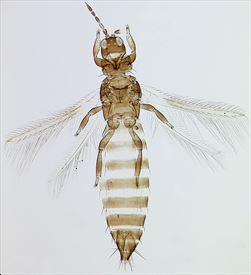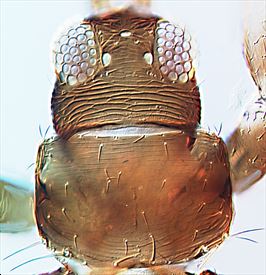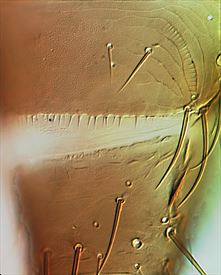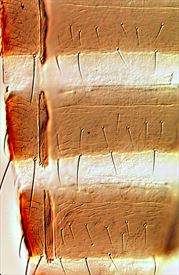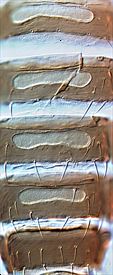Distinguishing features
Both sexes fully winged. Female dark brown, tarsi and antennal segment III yellowish brown; fore wings brown with base paler. Antennae 8-segmented. Head wider than long; ocellar setae pair III small, arising just inside anterior margins of triangle; postocular setae pairs I & III slightly longer than ocellar setae III, pair II minute. Pronotal external postero-angular setae slightly shorter than inner pair; posterior margin with 3 or 4 pairs of setae. Metanotum reticulate medially, reticles elongate on posterior half, with faint sculptured markings inside most reticles; median setae short and arising behind anterior margin; campaniform sensilla absent. Fore wing first vein with about 7 setae on distal half, second vein with about 14 setae; clavus with 5 marginal setae. Tergite II with 3 lateral marginal setae; posterior margin of tergite VIII with complete but slightly irregular comb of microtrichia; pleurotergites without discal setae, sculptured with rows of coarsely ciliate microtrichia. Sternite II with 1 or 2 discal setae, III–VII with about 12 discal setae in single row.
Male smaller than female but similar in colour; tergite VIII with no posteromarginal comb; sternites III–VII each with large transverse pore plate, discal setae arising laterally.
Related species
There are 13 species of the genus Thrips recorded from New Zealand, out of a total of 280 species worldwide (Mound & Masumoto, 2005). Many of these species have the antennae clearly 7-segmented, whereas others have 8 segments. All members of Thrips genus have paired ctenidia on the tergites, and on tergite VIII these are postero-mesad to the spiracles, and they also lack ocellar setae pair I in front of the first ocellus. In contrast, Frankliniella species have ctenidia on tergite VIII antero-lateral to the spiracles, and a pair of setae is always present in front of the first ocellus. T. simplex is generally recognised from the reticulate metanotum, of which many of the reticles have internal markings, and the fore wing first vein bears more than four setae on the distal half.
Biological data
Feeding and breeding in flowers and on leaves of Iridaceae, mainly Gladiolus, but also Crocosmia, and Neomarica. The Gladiolus Thrips can cause serious streaking on the flowers of this valuable horticultural crop.
Distribution data
Widespread in New Zealand on its host plant (AK, CL, BP, GB, WI and WN / MC). Although originally from South Africa, the Gladiolus Thrips is now widespread around the world wherever Gladiolus is grown.
Family name
THRIPIDAE, THRIPINAE
Species name
Thrips simplex (Morison)
Original name and synonyms
Physothrips simplex Morison, 1930: 12
Taeniothrips gladioli Moulton & Steinweden, 1931: 20
Physothrips plurisetae Girault, 1933: 2
Taeniothrips quinani Moulton, 1936: 506
References
Moritz G, Mound LA, Morris DC & Goldarazena A (2004) Pest thrips of the world – visual and molecular identification of pest thrips. Cd-rom published by CBIT Brisbane. http://www.cbit.uq.edu.au/software/pestthrips/default.htm
Mound LA (2010) Species of the genus Thrips (Thysanoptera, Thripidae) from the Afro-tropical Region. Zootaxa 2423: 1–24.
Mound LA & Masumoto M (2005) The genus Thrips (Thysanoptera, Thripidae) in Australia, New Caledonia and New Zealand. Zootaxa 1020: 1–64.
Mound LA, Tree DC & Paris D (2012) OzThrips – Thysanoptera in Australia. http://www.ozthrips.org/

